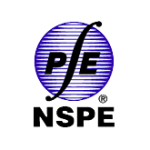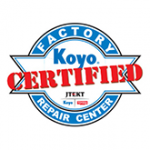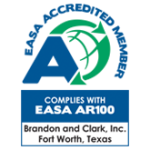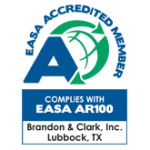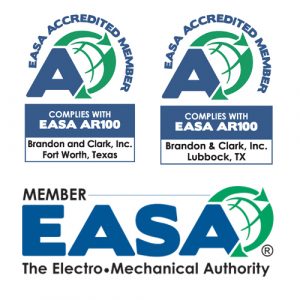
Proven by the Authority in Electrical Apparatus, EASA
Since 1953, Brandon and Clark has been a member of EASA, Electrical Apparatus Service Association. We are also an EASA Authorized Service Center, and have achieved the prestigious status of being an EASA Accredited Service Center by completing all the requirements set forth by EASA by demonstrating that we follow the prescribed good practices to consistently deliver quality electromechanical repairs that maintain or improve a motor’s efficiency and reliability.
Benefits of using an EASA Accredited Service Center
When you use Brandon and Clark, an EASA-accredited service center, you can be confident that:
- We are committed to excellence and value our professional reputation.
- We are dedicated to providing repairs that maintain or improve motor efficiency and reliability.
- We consistently follow proven best practice procedures that result in the highest quality repairs.
- We will repair your motors using well maintained equipment and accurately calibrated instruments (see www.easa.com/accreditation for a list of required equipment and calibration specifications).
- The quality of our work has been validated by independent third-party auditors, as well as by mandatory internal self audits.
- We continuously demonstrate to industry, energy advocates and regulatory agencies that we are dedicated to providing repairs that maintain efficiency and reliability.
- Our positive image helps us attract and retain experienced, highly trained employees that consistently perform procedures according to industry best practices.
- We follow best practices that enhance our productivity while reducing the possibility of errors and repetitive repairs–all of which means better service, improved reliability and less downtime for you.
- When you see our EASA Accreditation logo on your motor, you know it was repaired to the industry’s highest standards to maintain or even improve its efficiency and reliability.
About the EASA Accreditation Program
Assuring the efficiency and reliability of repaired electric motors
Overview
It has been proven that electric motor efficiency can be maintained by following defined good practice repair and rewind procedures. As a result, the Electrical Apparatus Service Association, Inc. (EASA) developed an international accreditation program for service centers that is based on the sources of these good practices, namely ANSI/EASA AR100: Recommended Practice for the Repair of Rotating Electrical Apparatus and the “Good Practice Guide” from the 2003 study The Effect of Repair/Rewinding on Motor Efficiency by EASA and the Association of Electrical and Mechanical Trades (AEMT).
This groundbreaking accreditation program uses EASA-approved independent, third-party auditors to evaluate service centers and assure they are following prescribed good practice electrical and mechanical repair procedures that maintain motor efficiency and reliability.
Scope
The EASA Accreditation Program covers three phase, squirrel-cage induction motors. Its scope includes both mechanical repairs and electrical rewinding.
Highlights
The EASA Accreditation Program for motor repair:
- Assures usage of prescribed good practices that help maintain motor efficiency and reliability
- Covers 23 categories and more than 70 criteria (see the “Audit Checklist with Explanations” at www.easa.com/accreditation)
- Requires external audits by EASA-approved independent, third-party auditors
- Assures continuing compliance with proven good practices through mandatory internal self audits
Covered Repair Processes

Compliance with the EASA Accreditation Program is assessed using a checklist that includes more than 70 criteria. Covered repair processes include:
- Instrument calibration
- Mechanical measurements
- Core testing and rewinding
- Bearing replacement and lubrication
- Bearing fit rebuilding
- Electrical testing
Other Memberships, Associations, Accreditation and Certifications

